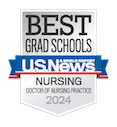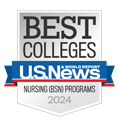Dr. Martyn's Research Seeks to Improve Sexual Risk Communication with Adolescents
A study by Dr. Kristy Martyn shows significant benefits to using Event History Calendars to facilitate communication.
Effective communication is a key element of any patient-healthcare provider relationship. Associate Professor Dr. Kristy Martyn’s innovative research reflects this essential understanding in the context of conversation with adolescent patients on sexual risk behavior, a context for which open and collaborative communication is particularly imperative—and challenging—to establish.
Dr. Martyn and her research team have recently completed the pilot test of an intervention approach using Event History Calendars (EHC) as a history-taking tool. The study was funded by NIH/NINR, The Michigan Center for Health Intervention. A report of the study, entitled, “Improving Sexual Risk Communication with Adolescents Using Event History Calendars,” was published in November 2011 in The Journal of School Nursing. Co-authors of the article include Clinical Assistant Professor Dr. Cynthia Darling-Fisher, Clinical Instructor Dr. Michelle Pardee, Research Scientist Dr. David Ronis, Program Coordinator Irene Felicetti, and Melissa Saftner, a PhD student at the time of the study.
Dr. Martyn, who serves as Chair of the Division of Health Promotion and Risk Reduction, was introduced to the EHC method soon after taking a faculty position at the School of Nursing in 1999. At that time, researchers at the U-M Institute for Social Research were using EHC in a variety of population-focused studies, though not in clinical settings. Dr. Martyn’s idea to tailor the EHC method for clinical use was thus unprecedented and allowed for a new and exciting set of applications to be considered. “This is a patient’s whole life on paper,” said Dr. Martyn, expressing how patients have reported their view of the EHC approach. “This is information that a doctor should know but does not.”
The recent study conducted by Dr. Martyn explored the use of EHC in a school-linked clinic. Thirty sexually-active, male and female adolescents were asked to fill out an EHC prior to their visit with a nurse practitioner (NP) at the clinic. The calendar prompted patients to answer questions regarding extracurricular activities, positive and negative events, family and friends, and sexual activity (partner, type, time span, and contraceptives used) in their lives currently and over the past two years. An additional column on the calendar provided space for patients to look forward to the following year and answer the questions as a goal-setting exercise. NPs then reviewed the adolescents’ EHCs with them as part of the clinic visit.
 Qualitatively and quantitatively, the study returned incredibly positive results. Both adolescents and NPs reported that the EHC helped to facilitate productive and detailed discussion of sexual risk behavior, as well as more effective communication overall. A pre-visit and post-visit comparative quantitative analysis of measures such as “satisfaction with communication” and “client involvement in decision-making” showed significant improvements in patient-practitioner communication. “The bottom line is that good history is only obtained through good communication, which leads to better diagnosis and better treatment,” explained Dr. Martyn.
Qualitatively and quantitatively, the study returned incredibly positive results. Both adolescents and NPs reported that the EHC helped to facilitate productive and detailed discussion of sexual risk behavior, as well as more effective communication overall. A pre-visit and post-visit comparative quantitative analysis of measures such as “satisfaction with communication” and “client involvement in decision-making” showed significant improvements in patient-practitioner communication. “The bottom line is that good history is only obtained through good communication, which leads to better diagnosis and better treatment,” explained Dr. Martyn.One-month post-intervention surveys of the adolescents’ sexual activity showed a significant change in behavior, though surveys conducted after three months did not show a significant change. Dr. Martyn hopes to further explore long term effects in future studies.
Two additional, unforeseen advantages of the EHC emerged from the pilot study. First, the EHC provided the opportunity to view co-occurrence of risks in a uniquely visual way. Given the format of the EHC, patients and practitioners could examine a column representing a single year and discuss potential interrelationships between events—such as beginning to take substances or feelings of depression—and sexual activity. Second, because adolescents were asked to fill out the EHC individually prior to the clinic visit, the task encouraged self-awareness of risk behavior. “That awareness is key to changing behavior,” said Dr. Martyn. She also commented that the collaboration between the NP and the patient while reviewing the EHC together was very beneficial. “That’s partnership,” she said. “That equalizes power.”
The results of this pilot study were used to apply for an NIH grant to fund a larger scale study, currently being carried out by Dr. Martyn and her research team. This study introduces a control group to better assess the effect of the EHC in improving communication. Moreover, the study will add two new settings for testing the intervention: a student health center and a community clinic. Dr. Martyn noted that the population of this second study will differ slightly from the first, as the pool of participants will include college-aged males and females, as well as individuals of Arab-American heritage, thus expanding the ethnic diversity of the participants beyond the previous white and African-American representation.
Dr. Martyn sees great potential for the EHC intervention approach to be used with a variety of populations and settings, as its advantages are relevant virtually wherever history-taking and communication could be improved upon. “It can be applied for all different kinds of patients,” she said. “This [type of intervention] is so untapped.”





